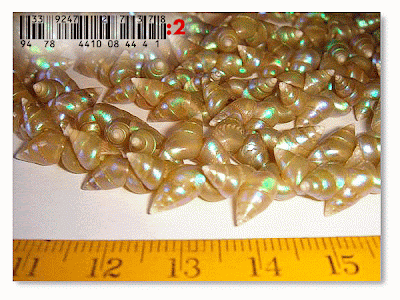 CLICK ON AN IMAGE TO ENLARGE
CLICK ON AN IMAGE TO ENLARGE CLICK ON AN IMAGE TO ENLARGE
CLICK ON AN IMAGE TO ENLARGE JW6710,
JW6710, the
eBAYER here, brings some special knowledge to this collection, namely qualifications and experience as a jewellery designer. The fact that she operates from an out of the way place says something about contemporary cultural production and the unlikely places
eBAY reaches.
JW6710 has supplied these images of a sample of her collection not only as a demonstration of what can be found on
eBAY but also the diversity of
maireener shell necklaces. From all accounts these necklace come 'provenance free' and one assumes these items come to light via clearance sales, estate auctions and the like. Apparently they are kind of things that hang around in bottom drawers as memoirs of the past and far too precious to throw away
– albeit that very often they are sold for very little.
NECKLACE # 6: The circumstantial evidence is that all of these shell necklaces are
quintessentially Tasmaniana but their
'cultural context' is nonetheless ambiguous. All but
#6 are typical of the
maireener necklaces turning up that bear all the hallmarks of being
'Hobart Necklaces'. The
#6 necklace is somewhat curious in that it is made using juvenile shells which in turn would mean that the effort in stringing is considerably more than
'the typical Hobart Necklaces'.
Extrapolated from this are the facts that given that commercially harvested shells were
paid for by the quart they may well have been less attractive to harvest. Also, given the additional number of shells in a necklace they would be more time consuming to string. If payment for stringing was paid by the piece these necklaces may have been more expensive.
Earnest Mawle's report 1918 makes no mention of the use of juvenile shells –
this does not by necessity discount their use in Hobart Necklaces however.

In Launceston in the 1940s/50s
maireener necklaces made with juvenile shells were available and circumstantially it seems that these necklaces were sourced in the Bass Strait Furneax Islands rather than Hobart –
and say the Bertie May operation. Albeit speculative, there is a first hand reports of necklaces made with juvenile shells being purchased at Wonderland Brisbane St. Launceston 1940s and circumstantially these necklaces are most likely to be of Aboriginal production on the Furneax Islands.
Thank you
JW6710 for sharing a part of your collection!
 Clearly this necklace has been dyed and in most other respects bears the hallmarks of a commercially produced 'Hobart Necklace'. The presence of a clasp reinforces this but it is hard to tell from the photographs if this thread is still dyed as it seem s that these necklaces were dyed after stringing. Almost all the circumstantial evidence points to this necklace being a Hobart Necklace and it being quite unlikely for it to have had a Tasmanian Aboriginal maker as is suggested here.
Clearly this necklace has been dyed and in most other respects bears the hallmarks of a commercially produced 'Hobart Necklace'. The presence of a clasp reinforces this but it is hard to tell from the photographs if this thread is still dyed as it seem s that these necklaces were dyed after stringing. Almost all the circumstantial evidence points to this necklace being a Hobart Necklace and it being quite unlikely for it to have had a Tasmanian Aboriginal maker as is suggested here.

































